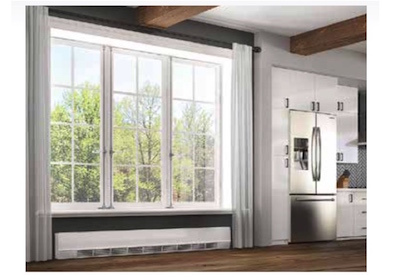Electric Heat: The “Greenest” Form of Heating for Your Home

Sept 22, 2019
Canadian households are facing a period of dynamic change. Electrification is transitioning us away from gas, oil, propane and other harmful carbon-emitting types of energy — to greener, cleaner electricity to power the systems we rely on to live, work… and move.
Begin your own electrification movement at home by using electricity to heat your home — and experience the comfort, convenience, safety and efficiency that an electric heating system can provide.
In this article, you will discover:
• Why Choose Electric Heat: The ”Five Shades of Green” Electric Heat Systems
• Types of Electric Resistance Heaters
• FAQ: What’s Next for Your Home
Discover the “Five Shades of Green” for Electric Heat Systems:
1. Efficiency. Electric heat solutions are 100% energy efficient — all of the energy taken in by the heater is converted into heat.
2. Environmental. Electric heat systems use electricity to operate — there is no need for natural gas or fossil fuels. With the electrical system shifting to support carbon-free and alternative energy sources (solar, wind, hydro), Canadians now have more choices than ever to reduce their carbon footprint.
3. Affordable. Electric heat systems use zone heating, which means used. Zone heating can produce energy savings of more than 20% compared to heating both occupied and unoccupied areas of your home.
4. Clean, safe and carbon-free. The solutions produce zero combustion in homes, so they are completely safe —this means, no carbon monoxide, odours, fumes, smoke, exhaust or noise.
5. Flexible and reliable. Electric resistance heat systems can be configured with non-programmable, programmable or smart/connected thermostats. Each type of thermostat offers increasing levels of control over temperatures in each room, providing optimal levels of comfort and energy cost savings. Electric heat systems are also reliable; the heating elements typically have a lifespan of over 25 years.
Reducing Canada’s carbon footprint begins with you
Canadian households are facing a period of dynamic change. An exciting new era known as Electrification is reshaping how energy is generated and distributed, as well as how it’s used in homes to power everything from heating and cooling systems, to electric car chargers.
Electricity is increasingly being produced from clean energy sources and is a key part of climate change policies —creating a socially-conscious energy infrastructure within Canada and around the world. It’s promising to know that in Canada, more than 80% of our electricity is generated from non-greenhouse gas-emitting sources, such as hydro, nuclear and renewables (solar, wind, geothermal) — making us one of the cleanest energy producers in the world! 1 But this effort to become a greener nation can’t stop there. We each have a responsibility to change how we power the systems we use at home.
Begin your own electrification movement at home by using electricity to heat your home — and experience the comfort, convenience, safety and efficiency that an electric heating system can provide.
Electrify your heating system at home
Did you know that heating accounts for 62% of the energy consumed in homes?[2] Installing an efficient heat source in your home presents an excellent opportunity to reduce overall heating costs and your ecological footprint. Electric heat is gaining traction because of its ease of use, comfort, reliability and environmental benefits. According to Statistics Canada, nearly 40% of Canadian homes are already heated with electricity.[3] Electricity is the most common energy source used for heating by households in Manitoba (49%), Quebec (92%), Newfoundland and Labrador (78%), and New Brunswick (60%). There is significant opportunity for Canadians in all regions to make the switch to a more sustainable form of heat for their homes.
Explore the many benefits that electric heat solutions can bring to your home — and experience the comfort of having direct warmth in active living spaces in your home. Electric resistance heat systems maximize comfort and minimize energy costs by converting 100% of incoming electric energy into heat and allowing you to control the temperature in the rooms you commonly use (zoned heating). Ask a licensed electrician or contractor which options are best for your home: you can choose from a wide selection of electric baseboards, convector heaters, fan-forced heaters or zoned radiant heaters — all of which can be easily installed in any home, old or new (see sidebar next page).
Why choose electric heat?
It’s affordable. One of the most common misconceptions about electric heat is that these systems are costly, when in fact, the purchase, installation, usage and maintenance costs of electric heat systems are typically less than other heating sources. While it’s true that operating costs can vary based on provincial electricity cost variations[4], the actual cost to operate an electric heat source is lower because it has fewer moving parts, so lower maintenance is required; it can be configured with different types of thermostats, allowing you to conveniently adjust heat settings for when you need it most; and supports zone heating – you only heat the rooms that you most commonly use.[5] Why pay for a central heat source that warms every room in your home, when you only use some of those rooms?
Types of electric resistance heaters
Electric baseboard heaters. This is the most common type of electric heater. It uses the convection method to quietly and evenly circulate warm air in a room. Baseboard heaters are ideal for any room and are usually installed below a window to counteract the effects of the colder window surface.
Electric convector heaters. This solution also uses the convection method to circulate warm air within a room. Convector heaters leverage their height to better circulate hot air within a room. Installation wise, these units are ideal for any room and can be positioned either under windows or on adjacent walls.
Electric fan heaters. Fan Heaters feature an electric fan that quickly transfers energy from the electric heating element to a room. These heaters are ideally suited for bathrooms or entryways, as they allow for the quick warm-up of a small space.
Electric radiant heat. This solution can be used indoors as normal room heaters and for in-floor heating needs. Radiant heating products such as in-floor heating and radiant room heaters provide direct heat, so even when the ambient air temperature in a room is low, those within range can still feel comfortable. Radiant heat is also ideal for outdoor spaces such as patios and in three-season rooms.
Electric thermal storage. This is a newer technology that stores electric heat during low demand times (night-time) when rates are lower. If your utility company offers this flexibility, you can expect to save costs because of the lower off-peak rates. The most common type of electric storage thermal system is a resistance heater.
Electric furnaces. This solution uses electric elements to produce heat, instead of gas burners (as used in conventional gas forced-air furnaces). Electric furnaces are a safe, clean option because the electric heating elements don’t require a flue to carry combustion gases outside and do not emit carbon monoxide into the air.
It’s reliable
Electric heat systems are very reliable as they virtually have no moving parts; they require relatively little maintenance and tend to last for a long time without requiring replacement. In fact, baseboard and convector heaters have proven to typically last an average of 25 years.[6]
It’s environmentally friendly
There has never been a better time to ‘go green’. Canada is taking great strides towards eliminating the use of coal for electricity generation by using renewable energy sources, such as solar and wind, to build a more efficient electricity generation landscape (see Exhibit 2). The electricity grid is also shifting towards clean energy; utility companies are retrofitting their generation stations to support alternative energy sources. Electric heat systems support these national efforts; they offer environmentally-friendly heating options that are fully compatible with electricity derived from renewable sources like wind and solar energy.
It offers advanced design options
Electric systems offer a variety of styles and colours to match the décor of any room. You can choose from a wide selection of baseboard and convector designs that best suit your needs. Even floor heating systems are completely hidden from view, providing complete flexibility in designing a space. With all of the upgrades you might do to a living space (paint, lighting, flooring), why not make your heat source warm and inviting?
FAQ: what’s next for your home?
The following are some of the most commonly asked questions that you might reflect on to better understand if electric heat is right for you.
Is my living/working space ideal for an electric heat system?
Any electric heat system can be used in any room of a home or in any environment, however, these systems work best in spaces that require direct and/or supplemental heating, such as in bedrooms, living rooms, basements or in new room additions. For instance, in-floor heat systems are ideal for bathrooms, whereas electric baseboards or convector heaters are more commonly used in bedrooms or living rooms. Before having a heating system sized, you should consider properly insulating and draft- proofing the rooms in your home. A thorough caulking, weather- stripping and insulation job add extra comfort and cost savings to your electric heat system.
What cost savings can I expect with an electric heat system?
Zone heating can provide you with more than 20% in energy savings compared to heating both occupied and unoccupied areas of your house.[7] While cost savings vary from province to province because of variances in electricity costs, some utility companies offer special incentives and programs to help you save. Contact your local utility to learn about the programs and incentives in your area.
Why should I choose an electronic thermostat for when nobody is at home or when everyone is asleep? Did you for my electric heat system?
Electronic thermostats help achieve substantial cost and energy savings. A study conducted by École Polytechnique Montréal showed that non-programmable electronic thermostats can achieve energy savings of up to 12% compared to mechanical thermostats. Programmable electronic thermostats resulted in energy savings of up to 20%, according to the same study. This difference is due to the fact that a programmable thermostat allows homeowners to automatically set a lower temperature know that the simple act of lowering your temperature by just three degrees at night can help save up to 6% in heating costs?
Where can I purchase an electric heat system and how do I install it?
Electric heat systems and related components are available from licensed electrical contractors. The systems can also be purchased at retail stores that sell heating and electrical equipment. It is important to ensure that all electric heat systems and components are installed by a licensed electrician and/ or electrical contractor.
Make the switch to an electric heating solution today!
Electric resistance heat continues to be a popular choice with consumers for good reason—simply put: it is affordable, efficient, safe, clean and comfortable. Also, with increasingly-sophisticated design options and compatibility with programmable thermostats and smart devices, you can experience new levels of flexibility in temperature control.
Advancements in electricity generation have paved the way for electric heat systems to be more versatile than ever before. Because the systems are electrical, they can harness the power of electricity to connect to a wide range of renewable energy sources such as solar and wind, making this solution a true green choice!
As with electric cars and home batteries, electric resistance heat is fast becoming the new way of gaining maximum comfort and efficiency for your heating needs. There has never been a better time to reconsider traditional heat sources and move towards re-evaluating the overall efficiency and effectiveness of your current heat system.
This article was developed by Electro-Federation Canada’s Electric Heat Section and was first published online.
Notes
1. “Electri-fyi: Exploring Electrification Trends and Opportunities in Canada”, Electro-Federation Canada (May 2019), p. 8. Web: https:/www.electrofed.com/wp-content/uploads/2019/06/Final-English-Electrification-White-Paper-LR.pdf
2. https:/www.nrcan.gc.ca/energy-facts/energy-and-greenhouse-gas-emissions-ghgs/20063
3. http:/www.statcan.gc.ca/pub/11-526-s/2013002/t002-eng.htm
4. The average price for electricity in Canada (residential) is 16.19 cents/kWh (Source: Hydro Quebec, “Comparison of Electricity Prices in Major North American Cities, 2018”)
5. Zone heating provides more than 20% in energy savings compared to heating both occupied and unoccupied areas in a home (Source: Energy Saver, http:/energy.gov/energysaver/electric-resistance-heating)
6 Compared to the typical lifespan of a gas unit, which is approx. 10-15 years – about half of an electric heat system. Source: http:/www.consumeraffairs.com/news/replacing-your-homes-heat-pump-031513.html
7 Energy Saver, http:/energy.gov/energysaver/electric-resistance-heating





![Guide to the Canadian Electrical Code, Part 1[i] – A Road Map: Section 52 — Diagnostic imaging installations](https://electricalindustry.ca/wp-content/uploads/2022/11/Guide-CE-Code-2-768x432.png)





![Guide to the Canadian Electrical Code, Part 1[i] – A Road Map: Section 52 — Diagnostic imaging installations](https://electricalindustry.ca/wp-content/uploads/2022/11/Guide-CE-Code-2.png)





